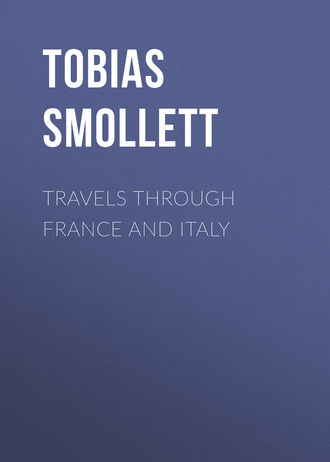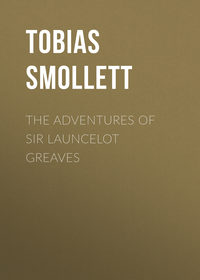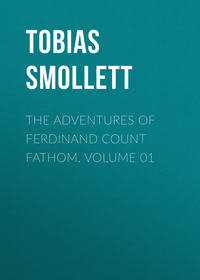 полная версия
полная версияПолная версия
Travels through France and Italy
These two statues weigh 116,257 pounds, and as they sustain nothing but a chair, are out of all proportion, inasmuch as the supporters ought to be suitable to the things supported. Here are four giants holding up the old wooden chair of the apostle Peter, if we may believe the book De Identitate Cathedrae Romanae, Of the Identity of the Roman Chair. The implements of popish superstition; such as relicks of pretended saints, ill-proportioned spires and bellfreys, and the nauseous repetition of the figure of the cross, which is in itself a very mean and disagreeable object, only fit for the prisons of condemned criminals, have contributed to introduce a vitious taste into the external architecture, as well as in the internal ornaments of our temples. All churches are built in the figure of a cross, which effectually prevents the eye from taking in the scope of the building, either without side or within; consequently robs the edifice of its proper effect. The palace of the Escurial in Spain is laid out in the shape of a gridiron, because the convent was built in consequence of a vow to St. Laurence, who was broiled like a barbecued pig. What pity it is, that the labours of painting should have been so much employed on the shocking subjects of the martyrology. Besides numberless pictures of the flagellation, crucifixion, and descent from the cross, we have Judith with the head of Holofernes, Herodias with the head of John the Baptist, Jael assassinating Sisera in his sleep, Peter writhing on the cross, Stephen battered with stones, Sebastian stuck full of arrows, Laurence frying upon the coals, Bartholomew flaed alive, and a hundred other pictures equally frightful, which can only serve to fill the mind with gloomy ideas, and encourage a spirit of religious fanaticism, which has always been attended with mischievous consequences to the community where it reigned.
The tribune of the great altar, consisting of four wreathed brass pillars, gilt, supporting a canopy, is doubtless very magnificent, if not over-charged with sculpture, fluting, foliage, festoons, and figures of boys and angels, which, with the hundred and twenty-two lamps of silver, continually burning below, serve rather to dazzle the eyes, and kindle the devotion of the ignorant vulgar, than to excite the admiration of a judicious observer.
There is nothing, I believe, in this famous structure, so worthy of applause, as the admirable symmetry and proportion of its parts. Notwithstanding all the carving, gilding, basso relievos, medallions, urns, statues, columns, and pictures with which it abounds, it does not, on the whole, appear over-crouded with ornaments. When you first enter, your eye is filled so equally and regularly, that nothing appears stupendous; and the church seems considerably smaller than it really is. The statues of children, that support the founts of holy water when observed from the door, seem to be of the natural size; but as you draw near, you perceive they are gigantic. In the same manner, the figures of the doves, with olive branches in their beaks, which are represented on the wall, appear to be within your reach; but as you approach them, they recede to a considerable height, as if they had flown upwards to avoid being taken.
I was much disappointed at sight of the Pantheon, which, after all that has been said of it, looks like a huge cockpit, open at top. The portico which Agrippa added to the building, is undoubtedly very noble, though, in my opinion, it corresponds but ill with the simplicity of the edifice. With all my veneration for the antients, I cannot see in what the beauty of the rotunda consists. It is no more than a plain unpierced cylinder, or circular wall, with two fillets and a cornice, having a vaulted roof or cupola, open in the centre. I mean the original building, without considering the vestibule of Agrippa. Within side it has much the air of a mausoleum. It was this appearance which, in all probability, suggested the thought to Boniface IV. to transport hither eight and twenty cart-loads of old rotten bones, dug from different burying-places, and then dedicate it as a church to the blessed Virgin and all the holy martyrs. I am not one of those who think it is well lighted by the hole at the top, which is about nine and twenty feet in diameter, although the author of the Grand Tour calls it but nine. The same author says, there is a descent of eleven steps to go into it; that it is a hundred and forty-four feet in heighth, and as many in breadth; that it was covered with copper, which, with the brass nails of the portico, pope Urban VIII. took away, and converted into the four wreathed pillars that support the canopy of the high altar in the church of St. Peter, &c. The truth is, before the time of pope Alexander VII. the earth was so raised as to cover part of the temple, and there was a descent of some steps into the porch: but that pontiff ordered the ground to be pared away to the very pedestal or base of the portico, which is now even with the street, so that there is no descent whatsoever. The height is two hundred palmi, and the breadth two hundred and eighteen; which, reckoning fife palmi at nine inches, will bring the height to one hundred and fifty, and the breadth to one hundred and sixty-three feet six inches. It was not any covering of copper which pope Urban VIII. removed, but large brass beams, which supported the roof of the portico. They weighed 186,392 pounds; and afforded metal enough not only for the pillars in St. Peter's church, but also for several pieces of artillery that are now in the castle of St. Angelo. What is more extraordinary, the gilding of those columns is said to have cost forty thousand golden crowns: sure money was never worse laid out. Urban VIII. likewise added two bellfrey towers to the rotunda; and I wonder he did not cover the central hole with glass, as it must be very inconvenient and disagreeable to those who go to church below, to be exposed to the rain in wet weather, which must also render it very damp and unwholesome. I visited it several times, and each time it looked more and more gloomy and sepulchral.
The magnificence of the Romans was not so conspicuous in their temples, as in their theatres, amphitheatres, circusses, naumachia, aqueducts, triumphal arches, porticoes, basilicae, but especially their thermae, or bathing-places. A great number of their temples were small and inconsiderable; not one of them was comparable either for size or magnificence, to the modern church of St. Peter of the Vatican. The famous temple of Jupiter Capitolinus was neither half so long, nor half so broad: it was but two hundred feet in length, and one hundred and eighty-five in breadth; whereas the length of St. Peter's extends to six hundred and thirty-eight feet, and the breadth to above five hundred. It is very near twice as large as the temple of Jupiter Olympius in Greece, which was counted one of the seven wonders of the world. But I shall take another opportunity to explain myself further on the antiquities of this city; a subject, upon which I am disposed to be (perhaps impertinently) circumstantial. When I begin to run riot, you should cheek me with the freedom of a friend. The most distant hint will be sufficient to,—Dear Sir, Yours assuredly.
LETTER XXXII
NICE, March 10, 1765.DEAR SIR,—The Colossaeum or amphitheatre built by Flavius Vespasian, is the most stupendous work of the kind which antiquity can produce. Near one half of the external circuit still remains, consisting of four tire of arcades, adorned with columns of four orders, Doric, Ionic, Corinthian, and Composite. The height and extent of it may be guessed from the number of spectators it contained, amounting to one hundred thousand; and yet, according to Fontana's mensuration, it could not contain above thirty-four thousand persons sitting, allowing a foot and an half for each person: for the circuit of the whole building did not exceed one thousand five hundred and sixty feet. The amphitheatre at Verona is one thousand two hundred and ninety feet in circumference; and that of Nismes, one thousand and eighty. The Colossaeum was built by Vespasian, who employed thirty thousand Jewish slaves in the work; but finished and dedicated by his son Titus, who, on the first day of its being opened, produced fifty thousand wild beasts, which were all killed in the arena. The Romans were undoubtedly a barbarous people, who delighted in horrible spectacles. They viewed with pleasure the dead bodies of criminals dragged through the streets, or thrown down the Scalae Gemoniae and Tarpeian rock, for their contemplation. Their rostra were generally adorned with the heads of some remarkable citizens, like Temple-Bar, at London. They even bore the sight of Tully's head fixed upon that very rostrum where he had so often ravished their ears with all the charms of eloquence, in pleading the cause of innocence and public virtue. They took delight in seeing their fellow-creatures torn in pieces by wild beasts, in the amphitheatre. They shouted with applause when they saw a poor dwarf or slave killed by his adversary; but their transports were altogether extravagant, when the devoted captives were obliged to fight in troops, till one side was entirely butchered by the other. Nero produced four hundred senators, and six hundred of the equestrian order, as gladiators in the public arena: even the women fought with wild beasts, as well as with each other, and drenched the amphitheatres with their blood. Tacitus says, "Sed faeminarum illustrium, senatorumque filiorum plures per arenam faedati sunt," "But many sons of Senators, and even Matrons of the first Rank, exposed themselves in this vile exercise." The execrable custom of sacrificing captives or slaves at the tombs of their masters and great men, which is still preserved among the negroes of Africa, obtained also among the antients, Greeks as well as Romans. I could never, without horror and indignation, read that passage in the twenty-third book of the Iliad, which describes twelve valiant Trojan captives sacrificed by the inhuman Achilles at the tomb of his friend Patroclus.
Dodeka men Troon megathumon uias eathlousTous ama pantas pur eathiei.Twelve generous Trojans slaughtered in their Bloom,With thy lov'd Corse the Fire shall now consume.Even Virgil makes his pious Hero sacrifice eight Italian youths to the manes of Pallas. It is not at all clear to me, that a people is the more brave, the more they are accustomed to bloodshed in their public entertainments. True bravery is not savage but humane. Some of this sanguinary spirit is inherited by the inhabitants of a certain island that shall be nameless—but, mum for that. You will naturally suppose that the Coliseo was ruined by the barbarians who sacked the city of Rome: in effect, they robbed it of its ornaments and valuable materials; but it was reserved for the Goths and Vandals of modern Rome, to dismantle the edifice, and reduce it to its present ruinous condition. One part of it was demolished by pope Paul II. that he might employ the stones of it in building the palace of St. Mark. It was afterwards dilapidated for the same purposes, by the cardinals Riarius and Farnese, which last assumed the tiara under the name of Paul III. Notwithstanding these injuries, there is enough standing to convey a very sublime idea of ancient magnificence.
The Circi and Naumachia, if considered as buildings and artificial basins, are admirable; but if examined as areae intended for horse and chariot races, and artificial seas for exhibiting naval engagements, they seem to prove that the antient Romans were but indifferently skilled and exercised either in horsemanship or naval armaments. The inclosure of the emperor Caracalla's circus is still standing, and scarce affords breathing room for an English hunter. The Circus Maximus, by far the largest in Rome, was not so long as the Mall; and I will venture to affirm, that St. James's Park would make a much more ample and convenient scene for those diversions. I imagine an old Roman would be very much surprised to see an English race on the course at New-Market. The Circus Maximus was but three hundred yards in breadth. A good part of this was taken up by the spina, or middle space, adorned with temples, statues, and two great obelisks; as well as by the euripus, or canal, made by order of Julius Caesar, to contain crocodiles, and other aquatic animals, which were killed occasionally. This was so large, that Heliogabalus, having filled it with excellent wine, exhibited naval engagements in it, for the amusement of the people. It surrounded three sides of the square, so that the whole extent of the race did not much exceed an English mile; and when Probus was at the expence of filling the plain of it with fir-trees to form a wood for the chace of wild beasts, I question much if this forest was more extensive than the plantation in St. James's Park, on the south side of the canal: now I leave you to judge what ridicule a king of England would incur by converting this part of the park into a chace for any species of animals which are counted game in our country.
The Roman emperors seemed more disposed to elevate and surprize, than to conduct the public diversions according to the rules of reason and propriety. One would imagine, it was with this view they instituted their naumachia, or naval engagements, performed by half a dozen small gallies of a side in an artificial basin of fresh water. These gallies I suppose were not so large as common fishing-smacks, for they were moved by two, three, and four oars of a side according to their different rates, biremes, triremes, and quadriremes. I know this is a knotty point not yet determined; and that some antiquarians believe the Roman gallies had different tires or decks of oars; but this is a notion very ill supported, and quite contrary to all the figures of them that are preserved on antient coins and medals. Suetonius in the reign of Domitian, speaking of these naumachia, says, "Edidit navales pugnas, pene justarum classium, effosso, et circumducto juxta Tyberim lacu, atque inter maximas imbres prospectavit," "He exhibited naval engagements of almost intire fleets, in an artificial Lake formed for the purpose hard by the Tyber, and viewed them in the midst of excessive Rains." This artificial lake was not larger than the piece of water in Hyde-Park; and yet the historian says, it was almost large enough for real or intire fleets. How would a British sailor relish an advertisement that a mock engagement between two squadrons of men of war would be exhibited on such a day in the Serpentine river? or that the ships of the line taken from the enemy would be carried in procession from Hyde-Park-Corner to Tower-wharf? Certain it is, Lucullus, in one of his triumphs, had one hundred and ten ships of war (naves longas) carried through the streets of Rome. Nothing can give a more contemptible idea of their naval power, than this testimony of their historians, who declare that their seamen or mariners were formed by exercising small row-boats in an inclosed pool of fresh water. Had they not the sea within a few miles of them, and the river Tyber running through their capital! even this would have been much more proper for exercising their watermen, than a pond of still-water, not much larger than a cold-bath. I do believe in my conscience that half a dozen English frigates would have been able to defeat both the contending fleets at the famous battle of Actium, which has been so much celebrated in the annals of antiquity, as an event that decided the fate of empire.
It would employ me a whole month to describe the thermae or baths, the vast ruins of which are still to be seen within the walls of Rome, like the remains of so many separate citadels. The thermae Dioclesianae might be termed an august academy for the use and instruction of the Roman people. The pinacotheca of this building was a complete musaeum of all the curiosities of art and nature; and there were public schools for all the sciences. If I may judge by my eye, however, the thermae Antonianae built by Caracalla, were still more extensive and magnificent; they contained cells sufficient for two thousand three hundred persons to bathe at one time, without being seen by one another. They were adorned with all the charms of painting, architecture, and sculpture. The pipes for convoying the water were of silver. Many of the lavacra were of precious marble, illuminated by lamps of chrystal. Among the statues, were found the famous Toro, and Hercole Farnese.
Bathing was certainly necessary to health and cleanliness in a hot country like Italy, especially before the use of linen was known: but these purposes would have been much better answered by plunging into the Tyber, than by using the warm bath in the thermae, which became altogether a point of luxury borrowed from the effeminate Asiatics, and tended to debilitate the fibres already too much relaxed by the heat of the climate. True it is, they had baths of cool water for the summer: but in general they used it milk-warm, and often perfumed: they likewise indulged in vapour-baths, in order to enjoy a pleasing relaxation, which they likewise improved with odoriferous ointments.
The thermae consisted of a great variety of parts and conveniences; the natationes, or swimming places; the portici, where people amused themselves in walking, conversing, and disputing together, as Cicero says, In porticibus deambulantes disputabant; the basilicae, where the bathers assembled, before they entered, and after they came out of the bath; the atria, or ample courts, adorned with noble colonnades of Numidian marble and oriental granite; the ephibia, where the young men inured themselves to wrestling and other exercises; the frigidaria, or places kept cool by a constant draught of air, promoted by the disposition and number of the windows; the calidaria, where the water was warmed for the baths; the platanones, or delightful groves of sycamore; the stadia, for the performances of the athletae; the exedrae, or resting-places, provided with seats for those that were weary; the palestrae, where every one chose that exercise which pleased him best; the gymnasia, where poets, orators, and philosophers recited their works, and harangued for diversion; the eleotesia, where the fragrant oils and ointments were kept for the use of the bathers; and the conisteria, where the wrestlers were smeared with sand before they engaged. Of the thermae in Rome, some were mercenary, and some opened gratis. Marcus Agrippa, when he was edile, opened one hundred and seventy private baths, for the use of the people. In the public baths, where money was taken, each person paid a quadrans, about the value of our halfpenny, as Juvenal observes,
Caedere Sylvano porcum, quadrante lavari.The victim Pig to God Sylvanus slay,And for the public Bath a farthing pay.But after the hour of bathing was past, it sometimes cost a great deal more, according to Martial,
Balnea post decimam, lasso centumque petunturQuadrantes—The bathing hour is past, the waiter tir'd;An hundred Farthings now will be requir'd.Though there was no distinction in the places between the first patrician and the lowest plebeian, yet the nobility used their own silver and gold plate, for washing, eating, and drinking in the bath, together with towels of the finest linen. They likewise made use of the instrument called strigil, which was a kind of flesh-brush; a custom to which Persius alludes in this line,
I puer, et strigiles Crispini ad balnea defer.Here, Boy, this Brush to Crispin's Bagnio bear.The common people contented themselves with sponges. The bathing time was from noon till the evening, when the Romans ate their principal meal. Notice was given by a bell, or some such instrument, when the baths were opened, as we learn from Juvenal,
Redde Pilam, sonat Aes thermarum, ludere pergis?Virgine vis sola lotus abdire domum.Leave off; the Bath Bell rings—what, still play on?Perhaps the maid in private rubs you down.There were separate places for the two sexes; and indeed there were baths opened for the use of women only, at the expence of Agrippina, the mother of Nero, and some other matrons of the first quality. The use of bathing was become so habitual to the constitutions of the Romans, that Galen, in his book De Sanitate tuenda, mentions a certain philosopher, who, if he intermitted but one day in his bathing, was certainly attacked with a fever. In order to preserve decorum in the baths, a set of laws and regulations were published, and the thermae were put under the inspection of a censor, who was generally one of the first senators in Rome. Agrippa left his gardens and baths, which stood near the pantheon, to the Roman people: among the statues that adorned them was that of a youth naked, as going into the bath, so elegantly formed by the hand of Lysippus, that Tiberius, being struck with the beauty of it, ordered it to be transferred into his own palace: but the populace raised such a clamour against him, that he was fain to have it reconveyed to its former place. These noble baths were restored by Adrian, as we read in Spartian; but at present no part of them remains.
With respect to the present state of the old aqueducts, I can give you very little satisfaction. I only saw the ruins of that which conveyed the aqua Claudia, near the Porta Maggiore, and the Piazza of the Lateran. You know there were fourteen of those antient aqueducts, some of which brought water to Rome from the distance of forty miles. The channels of them were large enough to admit a man armed on horseback; and therefore when Rome was besieged by the Goths, who had cut off the water, Belisarius fortified them with works to prevent the enemy from entering the city by those conveyances. After that period, I suppose the antient aqueducts continued dry, and were suffered to run to ruins. Without all doubt, the Romans were greatly obliged to those benefactors, who raised such stupendous works for the benefit, as well as the embellishment of their city: but it might have been supplied with the same water through pipes at one hundredth part of the expence; and in that case the enemy would not have found it such an easy matter to cut it off. Those popes who have provided the modern city so plentifully with excellent water, are much to be commended for the care and expence, they have bestowed in restoring the streams called acqua Virgine, acqua Felice, and acqua Paolina, which afford such abundance of water as would plentifully supply a much larger city than modern Rome.
It is no wonder that M. Agrippa, the son-in-law, friend, and favourite of Augustus, should at the same time have been the idol of the people, considering how surprisingly he exerted himself for the emolument, convenience, and pleasure of his fellow-citizens. It was he who first conducted this acqua Virgine to Rome: he formed seven hundred reservoirs in the city; erected one hundred and five fountains; one hundred and thirty castella, or conduits, which works he adorned with three hundred statues, and four hundred pillars of marble, in the space of one year. He also brought into Rome, the aqua Julia, and restored the aqueduct of the aqua Marzia, which had fallen to decay. I have already observed the great number of baths which he opened for the people, and the magnificent thermae, with spacious gardens, which he bequeathed to them as a legacy. But these benefactions, great and munificent as they seem to be, were not the most important services he performed for the city of Rome. The common-sewers were first made by order of Tarquinius Priscus, not so much with a view to cleanliness, as by way of subterranean drains to the Velabrum, and in order to carry off the stagnant water, which remained in the lower parts, after heavy rains. The different branches of these channels united at the Forum, from whence by the cloaca Maxima, their contents were conveyed into the Tyber. This great cloaca was the work of Tarquinius Superbus. Other sewers were added by Marcus Cato, and Valerius Flaccus, the censors. All these drains having been choaked up and ruinous, were cleared and restored by Marcus Agrippa, who likewise undermined the whole city with canals of the same kind, for carrying of the filth; he strengthened and enlarged the cloaca maxima, so as to make it capable of receiving a large cart loaded with hay; and directed seven streams of water into these subterranean passages, in order to keep them always clean and open. If, notwithstanding all these conveniences, Vespasian was put to great expence in removing the ordure from the public streets, we have certainly a right to conclude that the antient Romans were not more cleanly than the modern Italians.










